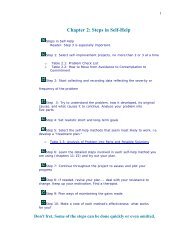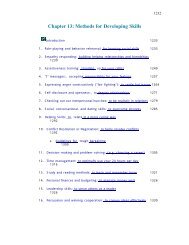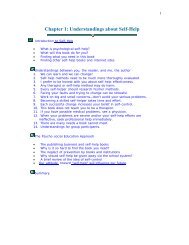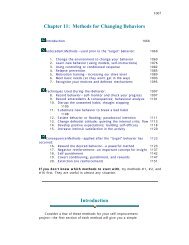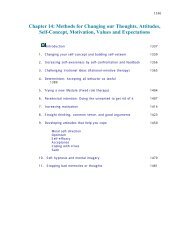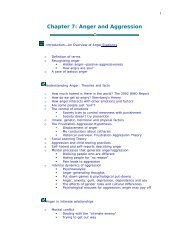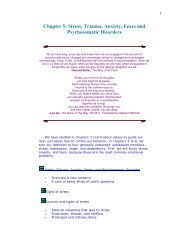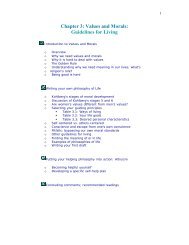Chapter 12: Methods for Changing Emotions - Psychological Self-Help
Chapter 12: Methods for Changing Emotions - Psychological Self-Help
Chapter 12: Methods for Changing Emotions - Psychological Self-Help
You also want an ePaper? Increase the reach of your titles
YUMPU automatically turns print PDFs into web optimized ePapers that Google loves.
1187<br />
Steps<br />
flying, the dark, bugs, public speaking, taking tests, meeting<br />
people, asserting one's self, being away from home and many<br />
other situations.<br />
· To break the connection between any given situation and an<br />
unwanted emotional response, e.g. to extinguish depression<br />
or anger associated with a certain person or behavior or<br />
situation. For instance, several students have used this method<br />
to reduce their jealousy when a date or spouse attends to<br />
another person.<br />
STEP ONE: Learn a method of relaxing<br />
Deep- muscle relaxation is recommended, but any method that<br />
works well <strong>for</strong> you is fine. Some therapists use drugs; self-hypnosis<br />
(chapter 14) might be a good choice. You may find that a certain time<br />
or place relaxes you, e.g. right after awakening, after exercising, or in<br />
bed late at night. Thorough, strong relaxation is necessary because it<br />
must over-ride the fear reaction.<br />
Recently, a new, rather strange sounding desensitization procedure<br />
has been developed <strong>for</strong> use by professionals (Shapiro, 1995). Instead<br />
of using relaxation, this method uses rapid eye movements (left and<br />
right), much like what occurs with the eyes closed during dreams. The<br />
therapist quickly moves his/her finger back and <strong>for</strong>th in front of the<br />
client and the client follows the finger with his/her eyes. While moving<br />
his/her eyes, the client also focuses his/her awareness on the<br />
traumatic memory or scary scene... and he/she should also focus on<br />
the physical bodily sensations associated with the fear or anxiety.<br />
Rapid reduction of the fearful reactions are reported. In addition,<br />
repressed traumas are sometimes uncovered and new positive feelings<br />
about themelves are claimed by some clients after only an hour or two<br />
of this process. More research of this procedure is needed but it is an<br />
interesting finding (I expected it would go the way of Silva Mind<br />
Control, EST Seminars, NLP eye movements, etc. but it hasn't yet; it<br />
has strong supporters and critics.).<br />
Dr. Richmond provides detailed instructions <strong>for</strong> Systematic<br />
Desensitization ( http://members.aol.com/avpsyrich/sysden.htm) very<br />
similar to mine. At this page you can also find links to several other<br />
self-help methods, such as Progressive Muscle Relaxation<br />
( http://members.aol.com/avpsyrich/intro.htm) , meditation, and<br />
prayer. We will use deep muscle relaxation in our example.<br />
STEP TWO: Study your fear response (or other emotional<br />
response)<br />
Every time you have the unwanted emotional response, record<br />
these five things: (a) the antecedents or situation prior to the<br />
emotional response, (b) the feelings you have, e.g. fear or anger,<br />
including the intensity on a scale of 0 to 99, (c) the thoughts you



